

 |
 |
Wondering around SHOT Show trying to find new and exciting products that were worth mentioning here is harder than one might think. While there were thousands of new outdoor toys, most were oriented towards specific markets and had little use outside those markets. But at a few booths I found a new gizmo or gadget that was worth taking time to get to know better.
![]() Assembling this SHOT Show Report is a major undertaking and was especially expensive with the show in Orlando this year. Without the support provided by generous ETS contributors who donated money to assist us and the sponsorship by Red Flare we couldn't have done it. Please drop by Red Flare's site and take advantage of their special deals for Equipped To Survive visitors. Please also consider making a tax-deductible donation to the Equipped To Survive Foundation if you find this report to be of value to you. The Equipped To Survive Foundation is a tax-exempt non-profit corporation that supports the continued operation and expansion of Equipped To Survive® and which allows me to attend shows such as this and report to you on the latest and greatest gear. In many cases Equipped To Survive® has been first by months to publicize new and exciting survival and preparedness gear. Again, donations are fully tax-deductible. Click here to make a tax-deductible donation or to find out more. Thanks very much for your support and consideration.
Assembling this SHOT Show Report is a major undertaking and was especially expensive with the show in Orlando this year. Without the support provided by generous ETS contributors who donated money to assist us and the sponsorship by Red Flare we couldn't have done it. Please drop by Red Flare's site and take advantage of their special deals for Equipped To Survive visitors. Please also consider making a tax-deductible donation to the Equipped To Survive Foundation if you find this report to be of value to you. The Equipped To Survive Foundation is a tax-exempt non-profit corporation that supports the continued operation and expansion of Equipped To Survive® and which allows me to attend shows such as this and report to you on the latest and greatest gear. In many cases Equipped To Survive® has been first by months to publicize new and exciting survival and preparedness gear. Again, donations are fully tax-deductible. Click here to make a tax-deductible donation or to find out more. Thanks very much for your support and consideration.
The survival gear covered here are those that are appropriate for wilderness survival or general utility use or which otherwise captured our imagination or attention.
Prices quoted are manufacturer's suggested retail price as of January, 2007, rounded to the nearest whole dollar. Most knives and tools covered here can be purchased at significantly discounted prices from those quoted. In some cases, items will not be available until much later this year. When we have been given an expected production date, we have included it, but manufacturers often miss such targets and many others do not provide one.
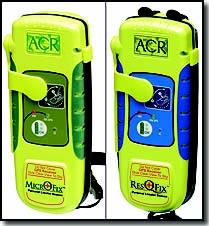 ACR Electronics chose SHOT Show to debut their long anticipated PLB-300 MicrOFix / ResQFix 406 Personal Locator Beacons. ACR claims this is the world's smallest PLB with built in GPS. It is 35% smaller and 25% lighter than its predecessor, the ACR TerraFix, weighing in at just 9.8 oz. Size is 1.4 x 5.85 x 2.21 inches. This truly is approaching pocket size and weight (image below shows the original ACR GyPSI PLB-100, the predecessor PLB-200 (Terra-/Aqua-/AeroFix) and the new PLB-300).
ACR Electronics chose SHOT Show to debut their long anticipated PLB-300 MicrOFix / ResQFix 406 Personal Locator Beacons. ACR claims this is the world's smallest PLB with built in GPS. It is 35% smaller and 25% lighter than its predecessor, the ACR TerraFix, weighing in at just 9.8 oz. Size is 1.4 x 5.85 x 2.21 inches. This truly is approaching pocket size and weight (image below shows the original ACR GyPSI PLB-100, the predecessor PLB-200 (Terra-/Aqua-/AeroFix) and the new PLB-300).
Both new beacons are functionally the same, the only differences being the color of the control panel and rubberized gripping surfaces and the ResQFix comes with a floatation jacket (pouch) of neoprene foam. The latter is recommended for use in marine environments because the PLB is not inherently buoyant, but the pouch is sort of an afterthought and a bit awkward, so as long as you use the provided tether to clip it to yourself (such as to your belt or vest), I think the standard MicrOFix is fine. That won't help if you just have it laying around and it can be accidentally lost overboard. In that case, get the ResQFix and keep it in its jacket. I'll use "MicrOFix" in this article to refer to both for simplicity's sake.
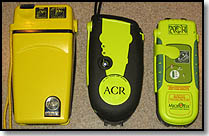 Activation is by a single red ON button, protected by the tab attached to the antenna, Deploying the flat stainless steel antenna, similar to that of the existing PLB 200 model, is easy even with gloves on. Slip the end out of the retention slot and pivot the antenna up until it clicks in place (it will rotate up to 180 degrees to allow for vertical antenna orientation even if the PLB is upright). This uncovers the ON button. A single button makes activation easy with a single hand, especially compared to the two-button system on the prior design, one of its drawbacks that this new PLB addresses. We like survival gear that is one-hand operable, it provides an additonal margin for survival in difficult circumstances. Click here to download and view a video of the MicrOFix PLB being activated with one hand (.AVI 467Kb) or Click here to view on YouTube.
Activation is by a single red ON button, protected by the tab attached to the antenna, Deploying the flat stainless steel antenna, similar to that of the existing PLB 200 model, is easy even with gloves on. Slip the end out of the retention slot and pivot the antenna up until it clicks in place (it will rotate up to 180 degrees to allow for vertical antenna orientation even if the PLB is upright). This uncovers the ON button. A single button makes activation easy with a single hand, especially compared to the two-button system on the prior design, one of its drawbacks that this new PLB addresses. We like survival gear that is one-hand operable, it provides an additonal margin for survival in difficult circumstances. Click here to download and view a video of the MicrOFix PLB being activated with one hand (.AVI 467Kb) or Click here to view on YouTube.
 |
| MicrOFix one-handed activation Video (.AVI 467Kb) |
The MicrOFix includes the usual full functional self-test including battery voltage and power indication and a test of 406 MHz transmission. It also includes a test of GPS acquisition for increased consumer confidence. There is no external GPS capability and there will be no non-GPS-equipped model.
It is nice to see that ACR has taken to heart many of the issues raised in our earlier beacon evaluations. The design addresses most of these issues and reportedly exceeds the proposed new standards we have been working on in the RTCM SC110 committee. For example, it is waterproof up to 16 ft (5 m) for one hour and 33 ft (10 m) for ten minutes. The GPS antenna location is clearly marked, "GPS Receiver," and critical instructions are provided as per the new standard and as I originally recommended: "Do Not Cover" and "Give Clear View of Sky."
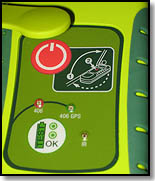 Human factors played a large role in the design. The rubberized side grips are designed to make this the natural place to hold the beacon, away from the GPS receiver. The area of the GPS receiver is raised, making it a less comfortable place the grasp and more obvious to a user, even in the dark.
Human factors played a large role in the design. The rubberized side grips are designed to make this the natural place to hold the beacon, away from the GPS receiver. The area of the GPS receiver is raised, making it a less comfortable place the grasp and more obvious to a user, even in the dark.
UPDATED: May 16, 2007: ACR invested a significant sum in a sophisticated GPS simulator to enhance their in-house design and testing capabilities for the GPS integrated into their PLB. They originally reported to us that they had optimized the GPS performance to ensure it would function well even in instances where the GPS receiver was covered up. In testing, it was shown that it would gain a GPS fix under optimum conditions even with a hand covering the GPS receiver or if stuffed into a pocket not oriented to the sky. This substantially improves the likelihood that the GPS coordinates will be transmitted with the distress signal, hastening rescue, even if the user doesn't operate the beacon in accordance with instructions. In other words, they worked hard to compensate for human nature. I like that design philosophy.
However, the best laid plans... It turned out that getting this performance on a production line was more difficult than anyone foresaw. Each GPS receiver had to be hand-tuned, which became a production bottle neck. In May they made the difficult decision to stop this tuning until they could figure out a more efficient method. As they pointed out, this was never a capability they advertised and I was the only journalist who was ever given a demonstration of this capability, so they don't feel like they are reneging on any public performance claims. In questioning, ACR revealed that the MicrOFix still has better GPS receiver performance than the PLB-200. The GPS receiver itself is in excess of -1 dBm more sensitive. That may not sound like much, but it's a huge difference. They also note that the "electronic design" of the MicrOFix is "less noisy and produces less internally induced interference," allowing for better performance. The MicOFix's more advanced software allows the GPS to establish a positon with only three satellites in view. ACR says they haven’t given up on being able to build the MicrOFix with the ability to receive even when the antenna is blocked and hope to be able to introduce that feature, officially, in the future.
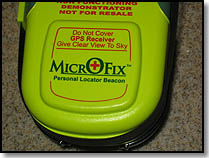 While ACR says they are confident that the overall GPS performance in less than optimal conditions is improved over the PLB 200 due to use of latest generation GPS components (which contribute to that dramatically superior "in-pocket" performance), they were not able to characterize for us how much improved it is at this point.
While ACR says they are confident that the overall GPS performance in less than optimal conditions is improved over the PLB 200 due to use of latest generation GPS components (which contribute to that dramatically superior "in-pocket" performance), they were not able to characterize for us how much improved it is at this point.
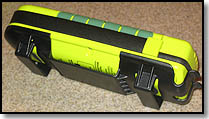 The MicrOFix comes with a hard plastic "bracket" that I'd describe as a carrier or holster. This is designed to be carried either horizontally or vertically on a belt or webbing strap. The PLB seems to be very secure in the carrier, secured at two points on the bottom and two on the top. The two top clips are raised to remove the PLB, which can be easily done one-handed if you raise one at a time. The antenna can be deployed while still in the carrier. My only concern is that the antenna is relatively easily slipped off the case where is wraps around the bottom. Perhaps they need to extend the ridges designed to keep it in place a wee bit to make it more secure.
The MicrOFix comes with a hard plastic "bracket" that I'd describe as a carrier or holster. This is designed to be carried either horizontally or vertically on a belt or webbing strap. The PLB seems to be very secure in the carrier, secured at two points on the bottom and two on the top. The two top clips are raised to remove the PLB, which can be easily done one-handed if you raise one at a time. The antenna can be deployed while still in the carrier. My only concern is that the antenna is relatively easily slipped off the case where is wraps around the bottom. Perhaps they need to extend the ridges designed to keep it in place a wee bit to make it more secure.
A fairly long wrist lanyard is attached with a clip and it is suggested that it be clipped to the carrier, just in case. The problem is that this leaves it dangling and it can easily catch on something. I think a far better solution, particularly for anyone using it on or over the water, would be one of Hammerhead Industries' Gear Keepers.
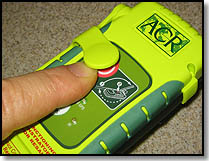 The only minor concern I had was that the tab covering the ON button is somewhat flexible and not held so tight over the button that something couldn't slip under it and possibly depress the ON button. Admittedly, not all that likely. ACR's solution is that to activate the MicrOFix, one must depress and hold the ON button for greater than one second and then the button must be released. If the button is not released, then it will not turn on. So, something that gets jammed in there isn't going to turn on the PLB. If the ON button is depressed and held for greater than 10 minutes the unit will go into a suspend or OFF mode and will not transmit until the button is released and then depressed for greater than one second and released in less than 10 minutes. Another safety, so to speak. The intent of these operational logic rules is to prevent the unit from activating if the button is inadvertently depressed in a pack or accidentally depressed for a moment.
The only minor concern I had was that the tab covering the ON button is somewhat flexible and not held so tight over the button that something couldn't slip under it and possibly depress the ON button. Admittedly, not all that likely. ACR's solution is that to activate the MicrOFix, one must depress and hold the ON button for greater than one second and then the button must be released. If the button is not released, then it will not turn on. So, something that gets jammed in there isn't going to turn on the PLB. If the ON button is depressed and held for greater than 10 minutes the unit will go into a suspend or OFF mode and will not transmit until the button is released and then depressed for greater than one second and released in less than 10 minutes. Another safety, so to speak. The intent of these operational logic rules is to prevent the unit from activating if the button is inadvertently depressed in a pack or accidentally depressed for a moment.
Given our vivid and inventive imagination of how things go wrong, based in large part on our experience and reading of others' experiences, we can foresee a few extraordinary circumstances where a combination of things could circumvent this protection, particularly when worn on a belt and traveling through dense plant growth, but it would be highly unlikely. Even in that case, the PLB beeps fairly loudly when activated and is unlikely to go unnoticed. So, bottom line, we don't think it's much of an issue or worth worrying about. Having said that, we'd prefer if there was a way to secure the PLB in its carrier so the control was inside and protected rather than exposed. You could also mitigate even this slim possibility by carrying it on the front of your body instead of on the side or simply carrying it a pocket, eliminating the issue entirely.
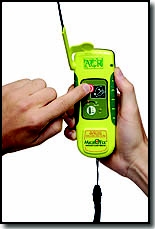 Typical operating life is given at 40 hrs at -4�F (-20�C) and 8 hrs at -40�F (-40�C). This significantly exceeds the battery performance of a Class II PLB (24 hours at -4� F) though it falls far short of a Class 1 PLB (24 hours at -40� F). These are reportedly conservative figures and we think that's a reasonable compromise to gain the advantages of smaller size and weight. Class I PLBs aren't very popular, and thus commercially unattractive, because of the huge weight and size penalty they engender for the larger batteries required.
Typical operating life is given at 40 hrs at -4�F (-20�C) and 8 hrs at -40�F (-40�C). This significantly exceeds the battery performance of a Class II PLB (24 hours at -4� F) though it falls far short of a Class 1 PLB (24 hours at -40� F). These are reportedly conservative figures and we think that's a reasonable compromise to gain the advantages of smaller size and weight. Class I PLBs aren't very popular, and thus commercially unattractive, because of the huge weight and size penalty they engender for the larger batteries required.
The lithium battery packs are non-hazmat, making shipping a lot less painful. As before, they have a five-year replacement cycle (11-year storage life). If experience is any measure, by then you'll want to replace it with the latest smaller and lighter PLB anyway.
MSRP for the MicrOFix is $750, but it is already being advertised on the web for $650 which is MAP. FCC approval has been received and deliveries are expected to begin late February to early March.
If that's still too rich for your blood, there's more good news. ACR will continue to offer the PLB-200 series of PLBs and have lowered the price by $100. This means that you should be able to purchase a 406 MHz PLB without GPS for around $450 and one with integral GPS for around $550. We think that's an excellent strategy that will result in more lives saved. For many people it wasn't the size and weight, but the price that was the problem. By lowering the price of entry, a lot more people will purchase a new PLB and eventually that translates to more rescues instead of body recoveries.
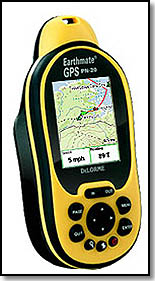 I (Alan Romania - ed.) am a land navigation nut. I love working with maps and compasses, and more recently, GPS. I teach land navigation with and without GPS and I am fascinated at how much GPS technology has advanced since they were first available to civilians in the late 1980's. GPS technology has added speed and accuracy to land navigation that isn't available with a map and compass. That being said, I also believe that the proliferation of GPS technology is one of the nails in traditional land navigation skills' coffin.
I (Alan Romania - ed.) am a land navigation nut. I love working with maps and compasses, and more recently, GPS. I teach land navigation with and without GPS and I am fascinated at how much GPS technology has advanced since they were first available to civilians in the late 1980's. GPS technology has added speed and accuracy to land navigation that isn't available with a map and compass. That being said, I also believe that the proliferation of GPS technology is one of the nails in traditional land navigation skills' coffin.
All too often I talk with those new to land navigation who expects that all they will ever need is their GPS. After all, nobody has ever had a battery operated device fail, have they? Some of these individuals listen to reason and learn how to read a map and use a compass; others walk away thinking I am an old-fashioned nutcase. My point? Before you get off the beaten path with just a GPS to guide you, learn how to read a map and use a compass and then learn how to incorporate your GPS into land navigation with a map and compass. Your trips to the outdoors will be much more enjoyable with the understanding that you really do know where you are and where you're going.
I had heard rumors that Delorme would be introducing a new GPS at SHOT Show this year, even after being told "you'll really like this one." However, I was not at all prepared for Delorme's PN-20 handheld GPS. Delorme answered the most common question I receive about mapping GPS; "is there any way I can add more detailed maps to my GPS." Delorme's answer is a resounding "yes."
The PN-20 is a full featured color screen GPS utilizing STMicroelectronics chip technology and a proprietary Kalman filter for enhanced GPS accuracy. Delorme promises 15-second warm up and 60-second cold location fix times, and with WAAS enabled, accuracy of less than 3 meters. The 5.12 ounce unit is 2.43" wide, 5.25" tall, and 1.5" deep and its impact-resistant rubberized housing is waterproof to IPX-7 (can be immersed in 1 meter of water for up to 30 minutes). It comes in my favorite color for outdoor gear, bright yellow. Users can choose to power the unit using two AA-batteries or an optional rechargeable battery pack.
The most remarkable feature of this GPS is its mapping capabilities. Delorme designed the PN-20 to work in concert with their TopoUSA mapping software. Included with the PN-20 is a version of TopoUSA 6.0 designed specifically to work with the GPS unit. Users can supplement the preloaded highway-level world maps on the unit with fully routable street and topographical maps from an included TopoUSA DVD. While many other GPS manufactures offer mapping software for their units, the detail available in Delorme's TopoUSA can exceed that available in 1:24,000 USGS 7.5" topographical maps. If that weren't enough, Delorme offers the user the option of downloading to you computer and loading to the PN-20 what they call ADP (aerial data packets). The ADP Downloads includes actual USGS 7.5" topographical maps, SAT-10 color satellite imagery, and black and white aerial imagery. If desired, one could have all four (USGS, TopoUSA, SAT-10 and Aerial) formats of an area loaded on their GPS so they have multiple views should they need it. These additional formats need to be purchased and downloaded from Delorme; a certificate is included for $100 worth of these data sets with the unit.
75 megabytes of memory not enough for all the maps you want? No problem, the unit has a SD card slot (yes, SD Card not one of those too-small-to-not-lose Mini- or Micro-SD cards, but an actual SD card) that allows you to expand the memory by up to 2 gigabytes. Delorme actually recommends that users buy a SD Card and a card reader when loading large maps onto the unit due to the increased speed of transfer and they offer a package with a 1 gigabyte card and reader. I have been a satisfied user of TopoUSA for a few years through various versions and have purchased and downloaded thousands of square miles of the ADP sets. The data quality and the capabilities of this program are remarkable considering it sells for under $100 for the entire United States and now it can be conveniently carred it into the field in a GPS.
I only had about 10 minutes to play with the demo devices that Delorme had at SHOT Show, so I cannot attest to the actual performance of the PN-20 in the field or the interface between the handheld unit and Delorme's TopoUSA 6.0. I can say that the unit was as intuitive to use as any GPS I have had the opportunity to use. The 2.2" (220 x 176 pixel) color screen was clear and easy to read, but I would like to see a larger screen given this units mapping capabilities. The basic unit sells for $370 (TopoUSA 6.0 included); a Deluxe package is available for $450 that includes a 1 gigabyte SD card, USB Card reader and a travel power kit (lithium ion rechargeable battery and 12v/120v charger, 12v & 120v adapter for USB power cable). The PN-20 available for purchase now. (More photos soon)
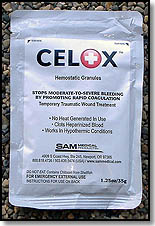 While not exactly new, Celox received their FDA approval in June of 2006; their hemostatic agent is worth mentioning as it is just now being widely distributed and readily available to civilians. Hemostatic agents are designed to stop bleeding by "clotting" the blood. Hemostatic agents have become popular in the last few years as the military seeks to curb the number one cause of preventable death on the battlefield, uncontrolled hemorrhaging. Many of these agents work well on minor wounds, but failed to adequately stop major bleeding. Other agents worked on major bleeding, but fail to perform well in the cold or produced too much heat in use. Others proved no better than a simple pressure dressing.
While not exactly new, Celox received their FDA approval in June of 2006; their hemostatic agent is worth mentioning as it is just now being widely distributed and readily available to civilians. Hemostatic agents are designed to stop bleeding by "clotting" the blood. Hemostatic agents have become popular in the last few years as the military seeks to curb the number one cause of preventable death on the battlefield, uncontrolled hemorrhaging. Many of these agents work well on minor wounds, but failed to adequately stop major bleeding. Other agents worked on major bleeding, but fail to perform well in the cold or produced too much heat in use. Others proved no better than a simple pressure dressing.
2006 saw a few new hemostatic agents introduced that show more promise. While many of these are unavailable to the public, and would be cost prohibitive for most users even if they were available, Celox is not only available, but is inexpensive enough to be included in many kits. Better yet, it works. Celox has been tested and shown to work on arterial bleeding, hepranized blood, and hypothermic patients (an issue with some earlier agents) with no known side effects. Asscociates who have been using it on the job validate every one of the claims made by Celox. Celox sells for $17 for a 15g package and $25 for a 35g package.
No special training is required for Celox; the on package instructions should be adequate for most users. The directions can be simple stated as; "open envelope, dump contents in wound, apply pressure for 5 minutes, wrap with dressing for transport" (refer to actual instructions before use). A couple 15g packs would be a great addition to anyone's first aid or medical kit. Be aware that Celox has a limited shelf life, like many medical products, of 3-years. For most markets, Celox is distributed by SAM Medical Products (yes, the SAM Splint folks).
| Return to SHOT Show 2007 Report home page |
| SELECT AND USE OUTDOORS AND SURVIVAL EQUIPMENT, SUPPLIES AND TECHNIQUES AT YOUR OWN RISK. Please review the full WARNING & DISCLAIMER about information on this site. |
Publisher and Editor: Doug Ritter
Email: Doug Ritter
URL:
http://www.equipped.org/shot_show_2007_gear.htm
First Published: February 12, 2007
Revision: 01 April 10, 2007
![]()
Email to: [email protected]
|